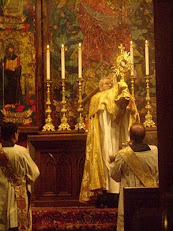On the heels of his excellent essay “United in Communion, but not Absorbed: Understanding the Pope’s Welcome,” Bishop Elliott has hit another home run with the following address delivered earlier today in Melbourne. My emphases in bold and comments in blue.
* * *
WHAT IS THIS “PERSONAL ORDINARIATE”?
Bishop Peter J. Elliott, Auxiliary Bishop of Melbourne, on Understanding Pope Benedict’s Offer to Traditional Anglicans
An address given to Forward in Faith Australia at All Saints’, Kooyong, Melbourne, on Saturday, February 13th 2010.
Anglicans can no longer speak of “swimming the Tiber”. Pope Benedict XVI has built a noble bridge, a symbol chosen as the cover illustration for the Catholic Truth Society edition of his Constitution Anglicanorum coetibus. Today I want to try to describe where that bridge leads...
read the rest at The Anglo-Catholic blog.
Obituary of a very failed Pontificate
-
"Nun khre methusthen kai tina per bian ponen, epei de katthane
Mursilos."Such would have been the reaction of the unchristianised Greeks.
But for us, for t...
6 months ago














More news here:
ReplyDeletehttp://www.forwardinfaith.com/artman/publish/article_501.shtml
Something like a "Friends of the Ordinariate"organization is what we could all do with as some of us prepare to join it.